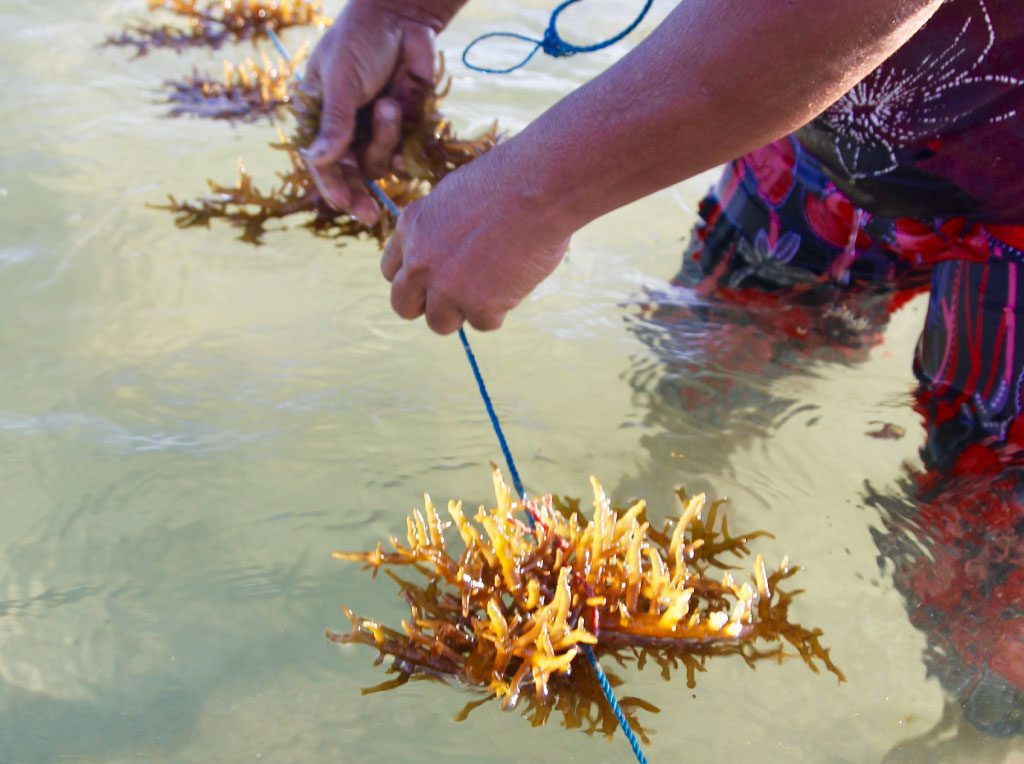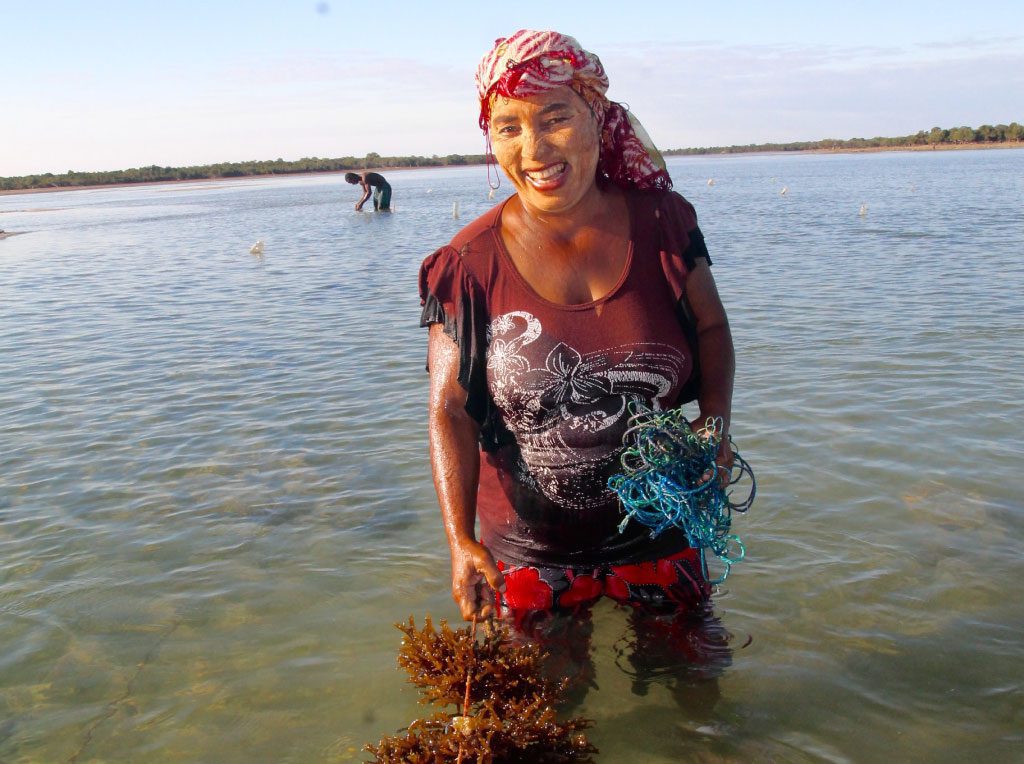The livelihoods and cultural identity of Vezo people in southwest Madagascar are intimately intertwined with the marine environment. Vezo livelihoods, however, are increasingly threatened by overfishing and mangrove deforestation, largely driven by demand from outside markets. Climate change is also having an impact, creating inconsistent wind patterns and rough seas too dangerous for fishing. Blue Ventures has been working with partners to pioneer viable alternatives to fishing to support alternative livelihoods, alleviating pressure on fisheries while gaining a new source of sustainable income through lomotse (seaweed) and zanga (sea cucumber) farming.
This series of aquaculture profiles, written by Angelina Skowronski, explores the opportunities for livelihood diversification and capacity building through the eyes and words of Vezo fishers themselves.
The sun is at high noon just a few days after winter solstice in Lamboara. Marie-Louise and five of her fellow seaweed farmers sit in ankle-deep water tending to cords of seaweed. The women laugh, sing and dance while working, and ever so often the word lomotse is spoken, the word for ‘seaweed’ in Malagasy.
Her hands have been doing this for four years now; her fingers operating on muscle memory at this point, speedily weaving delicate lomotse branches through bristled nylon cords.“Before lomotse, we spent our days gleaning horita (octopus). The sizes of horita were getting smaller and we weren’t able to earn enough money to feed our families,” said Marie-Louise as she ties another lomotse piece to her cord. Her hands have been doing this for four years now; her fingers operating on muscle memory at this point, speedily weaving delicate lomotse branches through bristled nylon cords.
At rano maiky (low tide) each day, the farmers tiptoe around spiky sea urchins and maze through sea grass to get to the seaweed farm. There aren’t any timecards, set schedules, or government-mandated breaks. The farmers’ schedules are based on the phases of the moon, which in turn determine the ebb and flow of the tides.
[Tweet “Farmers tiptoe around spiky sea urchins and maze through sea grass to get to the seaweed farm.”]
Lamboara’s rhythm has always followed these lunar cycles, as octopus gleaning, walking out onto the reef flat at low tide, is traditionally the main source of income for women in the community. Unlike fishing in laka (dugout outrigger canoes), which require long days at sea, octopus gleaning is ideal for women because it is less resource intensive, and requires minimal capital; just a sharp stick and a keen eye.

“Many women in Lamboara are single with an average of 5 children each, so it’s important that we have a reliable income so that we can feed our children and send them to school,” said Marie-Louise. “We don’t have a public school in this community, so if you want your children to go to school, you must pay to send them to the private school.”
In an effort to diversify coastal livelihoods and provide an alternative source of income for women in Lamboara, Blue Ventures, Copefrito, and Norges Vel supported the establishment of a community seaweed farm in 2011.
Today, seaweed farming is a popular occupation in Lamboara, harvesting approximately every two weeks during low tide. At rano maiky, the Indian Ocean flows out of the white sandy bay to expose the thriving environment: sea stars, sea anemones, mangrove roots, and 1142 lines of seaweed marked by buoys made from repurposed water bottles.
[Tweet “FIVELOMA translates to “livelihood” in Malagasy”]
The seaweed cultivation plays an important role in Lamboara, and in 2014, the farmers created an association called FIVELOMA (translates to “livelihood” in Malagasy). The objectives of the association are long-term; to create a savings committee for future projects and a retirement program for members.
Members pay a monthly due of 100 Ariary, the price of one cup of coffee. In addition to membership fees, the association allocates a percentage of their revenue from lomotse sales to the cooperative savings pot. Currently, the savings committee does not have immediate access to traditional financial institutions, but once they save a significant amount their goal is to transfer the money to a bank in the regional capital of Morombe.
“We come out here everyday to check on our lomotse, and sometimes our kids help when they are not in school,” said Marie-Louise. “More than co-workers, we are a family.”

Marie-Louise is the elected president of FIVELOMA. When asked about her personal five-year plan, she doesn’t talk about herself or her immediate family, but rather about FIVELOMA.
We are preparing for our future. We need sustainability to do this; both in our livelihoods and our environment.“We are preparing for our future,” she says in slow, articulated speech. She speaks in Vezo, the dialect of Malagasy spoken in this southwestern coastal slice of the country, “We need sustainability to do this; both in our livelihoods and our environment. The five-year goal of FIVELOMA is to fampiroboroboana (enhance, improve, or better) our lives.”
FIVELOMA members are so enthusiastic about the benefits of creating an association for cooperative savings that they have created a play to perform in other seaweed-farming communities informing them of the process and telling their story.
“We recognize that our future is also dependent on the activities of the communities around us,” continues Marie-Louise. “So we decided to spread this message through theatre to fampiroboroboana the world around us.”
This is the first in a series of aquaculture profiles, written and photographed by Angelina Skowronski, which explore the opportunities for livelihood diversification and capacity building through the eyes and words of Vezo fishers themselves.
You can find out more about our aquaculture work on our website. We would like to thank our partners for their commitment and expertise without which such projects would not be possible.
[vc_button title=”Support our work” target=”_blank” color=”default” size=”size_large2″ href=”https://blueventures.org/support/”]


